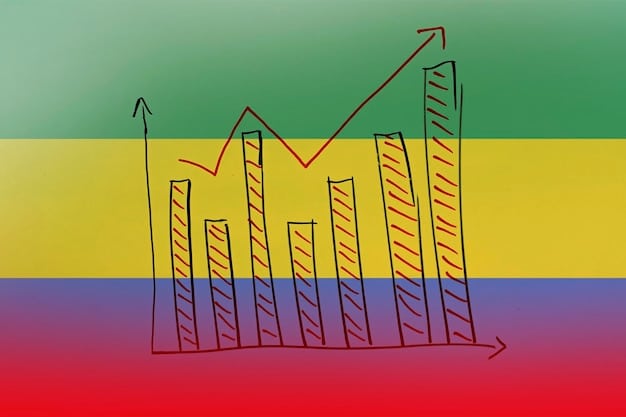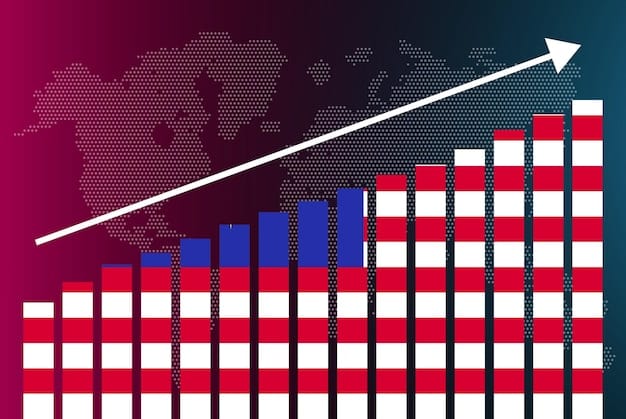Consumer Confidence Index: Impact on US Retail Sales

The Consumer Confidence Index (CCI) is a crucial economic indicator that measures how optimistic or pessimistic consumers are regarding the economy, providing insights into future spending and its potential impact on retail sales.
Understanding the Consumer Confidence Index: Decoding the Latest Numbers and Their Impact on Retail Sales is essential for businesses and investors alike. It provides a snapshot of consumer sentiment, which directly influences spending habits and shapes the retail landscape.
What is the Consumer Confidence Index (CCI)?
The Consumer Confidence Index (CCI) is a vital gauge of economic health, reflecting consumers’ feelings about current and future economic conditions. It’s a survey-based metric tracking optimism or pessimism, directly affecting spending and retail sales.
Understanding the CCI involves looking at its components and how it’s constructed. Here’s a breakdown:
CCI Components
The CCI is derived from survey questions that gauge consumer perceptions on various aspects of the economy.
- Business Conditions: How consumers feel about current business conditions.
- Short-Term Outlook: Expectations for business conditions in the next six months.
- Employment: Current perceptions of job availability.
- Short-Term Job Outlook: Expectations for job availability in the next six months.
- Income Expectations: Expectations for household income in the next six months.
CCI Calculation
Responses to the survey questions are used to create an index value. A baseline value of 100 represents a neutral level of consumer confidence. Scores above 100 indicate optimism, while those below 100 signal pessimism.
In conclusion, the CCI serves as a crucial economic indicator, providing insights into consumer behavior and its potential impact on retail sales and the broader economy.
How is the CCI Calculated and Reported?
Understanding how the Consumer Confidence Index (CCI) is calculated provides insights into its reliability. The CCI is carefully constructed and reported to ensure that it accurately reflects consumer sentiment.
The Conference Board, a non-profit organization, conducts the monthly survey that forms the basis of the CCI. Here’s how it works:
Survey Methodology
The Conference Board surveys approximately 5,000 households across the United States each month. The survey asks consumers about their views on current business conditions, short-term outlook, employment, and income expectations.
Data Compilation
After collecting survey responses, the Conference Board calculates the index value. Each question contributes equally to the overall index. The responses are seasonally adjusted to account for predictable variations throughout the year.
Reporting and Interpretation
The CCI is typically released on the last Tuesday of each month. The report includes the overall index value, as well as breakdowns by age, income, and region. Economists and analysts scrutinize the report to gauge the direction of consumer spending.

The CCI’s calculation and reporting provide valuable insight into consumer behavior, helping businesses and policymakers make informed decisions about the economy.
Historical Trends of the CCI in the US
Examining historical trends of the Consumer Confidence Index (CCI) provides a better understanding of its relationship with economic events. The CCI is a dynamic indicator that reacts to prevailing economic conditions.
Analyzing past CCI trends can reveal patterns and give context to current readings.
CCI During Recessions
Historically, the CCI tends to decline sharply during economic recessions. For example, during the 2008 financial crisis, the CCI plummeted as consumers worried about job security and the overall economy.
CCI During Expansions
Conversely, the CCI typically rises during periods of economic expansion. As the economy improves, consumers become more confident in their financial prospects and are more willing to spend.
Key Economic Events
Major economic events, such as changes in interest rates, fiscal policy, and global economic conditions, often influence the CCI. Monitoring these trends can help economists and analysts anticipate future economic developments.
Historical trends of the CCI offer a valuable lens for understanding consumer behavior and its correlation with economic cycles.
CCI vs. Other Economic Indicators
The Consumer Confidence Index (CCI) is just one of many economic indicators used to assess the health of the economy. Comparing it with other indicators provides a more comprehensive view of the economic landscape.
The CCI offers a unique perspective on consumer sentiment that complements conventional economic measures.
GDP
Gross Domestic Product (GDP) is a broad measure of economic output. While GDP provides a comprehensive look at the economy, the CCI offers insights into consumer spending patterns that drive much of GDP growth.
Unemployment Rate
The unemployment rate is a key indicator of labor market conditions. Changes in the unemployment rate can influence consumer confidence, as job security affects spending and saving decisions.
Inflation Rate
The inflation rate measures the rate at which prices for goods and services are rising. High inflation can erode consumer purchasing power and negatively impact the CCI.

Comparing the CCI with other economic indicators can provide a more nuanced understanding of the economy, enabling better decision-making for businesses and investors.
The Impact of CCI on Retail Sales
The relationship between the Consumer Confidence Index (CCI) and retail sales is significant. As consumer confidence rises, so does their willingness to spend, thus boosting retail sales.
Understanding this relationship allows businesses to anticipate market trends and adjust their strategies accordingly.
Direct Correlation
A high CCI generally correlates with increased retail sales. Confident consumers are more likely to make discretionary purchases, benefiting retailers across various sectors.
Consumer Spending Habits
The CCI influences consumer spending habits, including what types of goods and services consumers are willing to buy. For example, during periods of high confidence, consumers may be more inclined to purchase big-ticket items like appliances or cars.
Business Strategies
Retailers can use the CCI to inform their inventory management, marketing strategies, and pricing decisions. By understanding consumer sentiment, retailers can better align their offerings with demand.
In essence, the CCI serves as a valuable tool for retailers, providing insights into consumer behavior and helping them navigate market dynamics more effectively.
Strategies for Businesses Based on CCI Fluctuations
Businesses can employ different strategies to navigate fluctuations in the Consumer Confidence Index (CCI). Understanding how to respond to CCI changes is essential for maintaining profitability.
Here are some strategies businesses can use:
High CCI Strategies
- Expand Inventory: With increased consumer confidence, retailers can expand their inventory to meet rising demand.
- Increase Marketing: Businesses can ramp up marketing and promotional efforts to attract more customers.
- Introduce New Products: Confident consumers are often more willing to try new products and services.
Low CCI Strategies
- Cost-Cutting Measures: Businesses can implement cost-cutting measures to protect profit margins during periods of low consumer confidence.
- Promotions and Discounts: Offering discounts and promotions can incentivize consumers to spend, even during tough times.
- Focus on Essential Goods: Retailers can shift their focus to selling essential goods and services that consumers need, regardless of economic conditions.
By adapting strategies to align with CCI fluctuations, businesses can better navigate economic cycles and maintain long-term success.
| Key Point | Brief Description |
|---|---|
| 📊 CCI Definition | Measures consumer optimism about the economy. |
| 📈 CCI & Retail Sales | Higher CCI often leads to increased retail spending. |
| 📉 Recession Impact | CCI typically declines sharply during recessions. |
| 💰 Business Strategies | Adapt inventory and marketing based on CCI levels. |
FAQ
▼
The Consumer Confidence Index (CCI) measures how optimistic or pessimistic consumers are regarding the economy. It’s a key indicator of consumer sentiment and spending habits.
▼
The CCI is calculated from a monthly survey of about 5,000 households, assessing their views on business conditions, employment, and income expectations. The Conference Board compiles the results.
▼
A high CCI generally leads to increased retail sales as confident consumers are more willing to spend. Conversely, a low CCI can result in decreased spending and lower sales.
▼
Yes, businesses can use the CCI to guide inventory management, marketing efforts, and pricing decisions. Understanding consumer sentiment helps them adapt to economic conditions.
▼
The CCI is survey-based and may not always perfectly reflect actual consumer behavior. It should be used in conjunction with other economic indicators for a comprehensive view.
Conclusion
The Consumer Confidence Index (CCI) serves as an essential tool for understanding consumer sentiment and predicting retail sales trends. By monitoring the CCI and adapting business strategies accordingly, businesses can successfully navigate economic fluctuations and maintain a competitive edge.